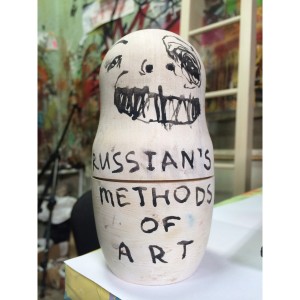The artwork. It serves as a sort of funnel condensing all of these kinds of loose concepts and really tying them together into something that’s presentable and it’s not… I think it serves in a way that science does that also, like this is just one possible solution, this is not the solution but this is just kind of like, this is a reflection of what’s happening in a very precise way, or informative way.
I think it’s tricky because I feel like the body of work is so much more important than the individual work. It’s kind of like no one sentence of what I even just said now is the work, it’s just, it’s part of this longer continuum and so to me it’s just this, you know it’s an accumulation of everything. So I think to take it as an individual work is kind of like, it’s like the sound bite or the single file and, it’s to me even then like an individual work is maybe less valuable than all of the work, you know? It’s a sentence in a book. It’s not as profound as even a chapter so… and that’s just because that’s how I approach it, I don’t approach works in terms of this large, you know, epic sculpture, like, „I have finished and it’s this masterpiece“, everything is kind of its own, it’s a process and so each of these is just another edition to that process, another manifestation.
The work is this kind of amorphous concept of documentation and theory and technology and then it touches down in the videos, in the paintings so no one has the full experience but that’s how most things, I think, are… it’s that, the concept becomes the work and then each manifestation becomes a different sort of piece of it.
I feel like the image is kind of an output in the same way that it’s like a file. So you can create the work as the file and then it’s visualized differently on each screen. Like on a laptop, or a phone, or on a monitor but I think it’s so… I’m not sure, abstract even with the image. It’s so not literal anymore, to just say, you know, „here is the image“. Like even with these, like these are paintings but they are not the work, the work even if I were to show this to someone to me the more accurate version of the work is the file version like the vector image of this painting is more direct and precise but there is no original… there is no… I guess it’s more idea based in that sense, the same with like a sentence or something like that. It’s so non visual, when it can touch down an object in a visual way but, yeah the work is much more generated in your mind now than it would have been in the past. I mean it’s the same if you talk about things that… I feel like the best way you could describe it especially with imagery that I create, it’s kind of like if you’ve got a play, and the play is this kind of general concept but no one execution of that play, or no one set of actors is the play, they are all this kind of thing that gets produced and see. So the image for this gallery show, the work is these object paintings but on the online gallery its a vector image and then if this is going to be shown somewhere else, I’m not going to ship these, because it doesn’t make sense, and I’m not going to fly locally and reproduce them again, is that I’ll have them printed locally and that’s still another set of actors that are producing the same play and because this is where I’ve moved, I think you moved the bar of where the work is, or where the artwork is back, and so rather than having it be this object this is just one manifestation, or one performance and no one is it, and no one isn’t it. It’s kind of like a coke bottle, its like everybody’s coke bottle looks the same but they are all the accurate concepts.
I mean the way that the chip works, I mean it’s very old technology. RFID is a very old technology and NFC is a layer protocol on top of that, so its a two way communication protocol that’s in a lot of phones, you see it in access cards to banks or my gym has the same NFC access cards. And it works a lot like a USB stick and this technology was first implemented in Camden, Warwick, it was like in 1999, when they developed this concept for being able to use it to turn on lights and kind of have it as a your body interacting with technology, and a lot of it… now the direction its‘ gone is with bio metrics where you can now use your Iris or your fingerprints or even make payments based on the blood vessel configuration in your hands versus using something that’s implanted. But the technology does exist and they tried to introduce it a few years ago for Alzheimer patients, or people that needed to have their medical knowledge easily transferred to a hospital if they didn’t have the ability to say on their own. And so, this particular chip is a newer model because its‘ NFC, so it contains date versus a bar code only, so therefore I can use it to store data on, so I use it to store, right now, it’s animated gifs. But I have… this as a curatorial space. So I have had artists that have designed music for it and images in small files that fit on to it, and that gets read by the phone in two different ways. One way is to scan it and it pulls up a website version of the same chip because that’s really quick because the internet is fast and if you don’t have the internet it can download the file which is in hex form so you just reconfigure that as a mp3 or a gif or whatever it is based on the header of the file. So yeah, the way it works, you just scan it and the phone picks up the NFC chip from there – so right now the one here is from a lenticular series that I did which is based on Photoshop tools and icons from Susan Care who designed those, and so this is just a little slide show, this is one gif that just loops through all of the tools from the series that they called Photoshop skills, and then I’ve got, this is the website version, you can slide through and see all the previous artists. This is Daniel Temkin, Deter Studies, and a month before that was Rob Manner’s, Splat ,which went along with his exhibition at transfer gallery in Brooklyn and then you can download it from there or use the app. But yeah I mean, it’s the same with this technology is that there is a lot of misunderstanding and there is this assumption that that chip could be used to track you or to control your mind or things like that. And it’s important just to say, “here is what it is.” And so these products are probably embedded in some of the articles of clothing you own because they are used as security measures, and a lot of sneakers have them and knowledge is power, you know? To know that those chips… what they do and how they can be misused and are in some instances… but it’s an older technology and this chip was like obsolete the second I installed it. it’s a piece of hardware that can’t be updated. Yeah, I mean I think a lot of people misunderstand its potential and things like that. Even like you know with my car, like there is a car door open for it and you can use it in your house but at certain point, it’s like, there are much easier ways to do that and so, I don’t think of it like as an enhancement, I think of it as an other where it’s like instead of wearing like a t-shirt of a band logo you get a tattoo of it. And that’s kind of what this is, rather than carrying around my phone with the files in it. I have this permanent location for them. So the idea is to have the proliferation of these animated gifs, so just not to keep them and have my secure copy. I have it as an open platform where people can download the file, it’s not secured with a password, like you normally use the chip to encode information like a padlock. this is freely accessible, very small files, just like a website.

















